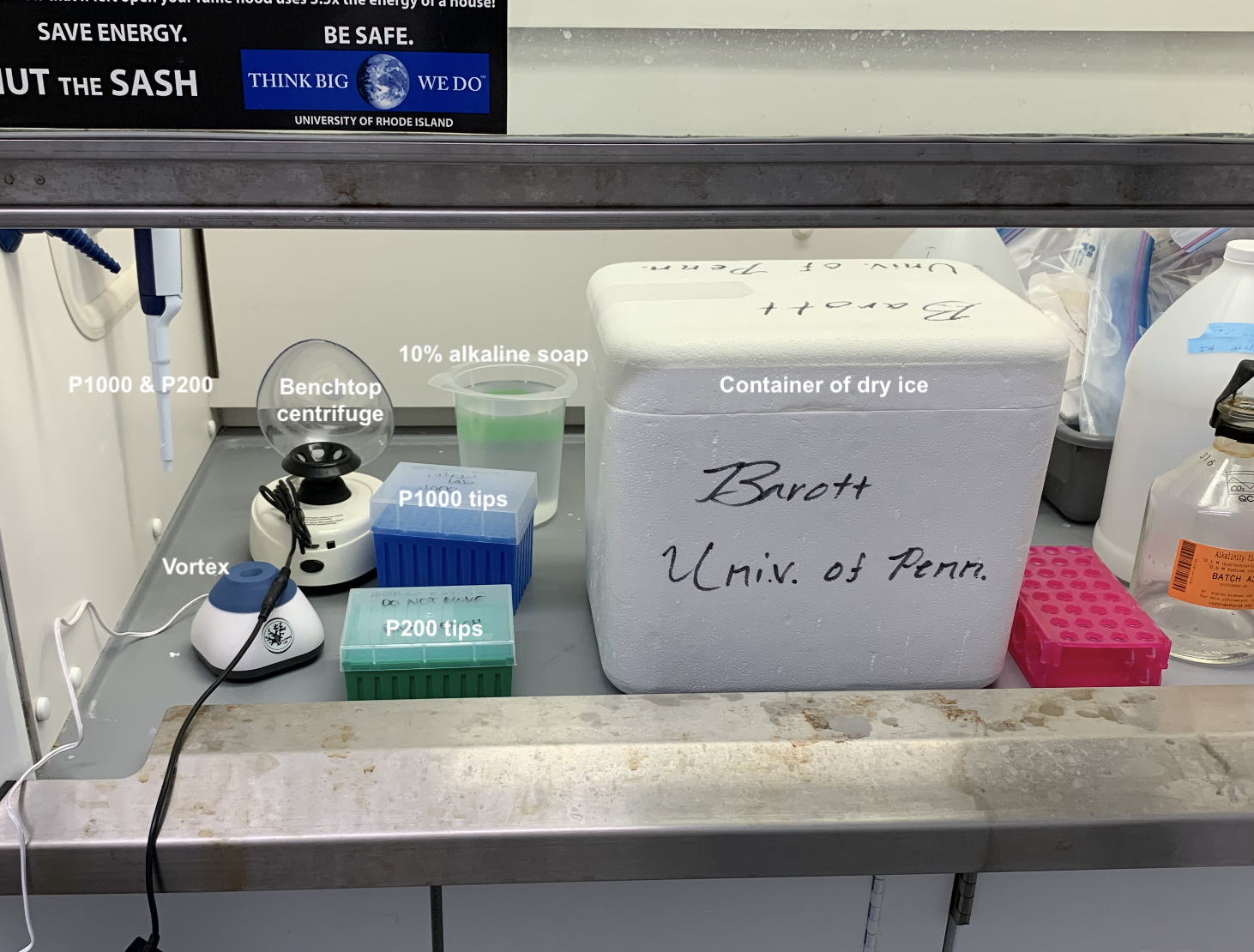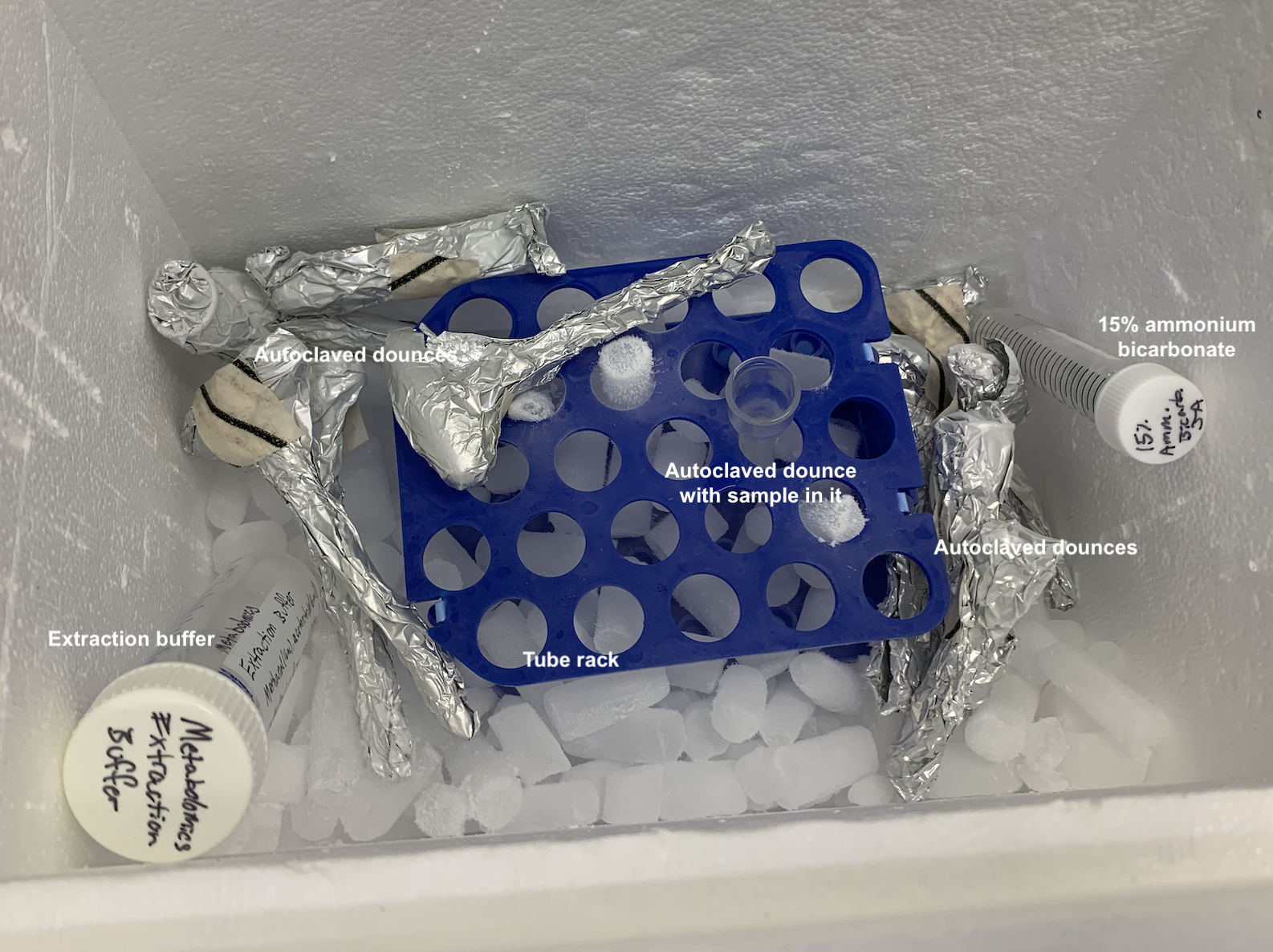Metabolomic extraction
Metabolomic extractions
This protocol details the process for larval metabolomic extraction.
- Stable isotope metabolomics larval protocol
- Stable isotope metabolomics extraction protocol
- AH and JA working protocol document
The samples used in this extraction are from A. Huffmyer’s 2021 M. capitata larval experiment. For experimental details, see the tag “Mcapitata LarvalTemp 2021” in A. Huffmyer’s lab notebook.
Equipment & materials
- 2 mL dounces
- 11 mm Snap Cap tubes
- 11 mm Snap Cap auto sampler vials
- 100um cell strainer
- Methanol
- Acetonitrile
- Formic Acid
- Water
- 1.5 mL tubes
- Dry ice
- P1000, P200 + tips
- 10% bleach
- 70% ethanol
- DI water
- Alkaline soap
Prior to extractions, autoclave all glassware.
Protocol
Make reagents
Prepare reagents according to KW’s protocol.
Extraction Buffer (500 µL per sample; make ~40 mL for this set of samples)
This extraction buffer is a ratio of 40:40:20 of methanol, acetonitrile, and water, with 0.5%[v/v] Formic Acid. Store at 4°C in a non-flammable fridge.
KW buffer prep:
- For a total of 200mL extraction buffer:
- 80 mL methanol
- 80 mL acetonitrile
- 40 mL water
- 1 mL formic acid
JA buffer prep (making less volume):
- For a total of 40mL extraction buffer:
- 16 mL methanol
- 16 mL acetonitrile
- 8 mL water
- 0.2 mL formic acid
15% Ammonium Bicarbonate Solution (44 µL per sample; make ~5 mL for this set of samples)
The solubility of Ammonium bicarbonate in water is: 220g/L for 100%. After solutions are prepped, tore at 4°C in a non-flammable fridge
- To make 100% Ammonium Bicarbonate solution (250 mL):
- 55g dry Ammonium bicarbonate
- 250 mL LCMS water
KW solution prep:
- To make 15% Ammonium Bicarbonate Solution (250 mL):
- 37.5 mL of 100% Ammonium Bicarbonate Solution
- 212.5 mL LCMS water
JA buffer prep (making less volume):
- To make 15% Ammonium Bicarbonate Solution (5 mL):
- 0.75 mL of 100% Ammonium Bicarbonate Solution
- 4.25 mL LCMS water
Do extractions
Prior to starting, label the following tubes for each sample fraction to intend to extract. The sample processing list is here. Here, # indicates the biological sample ID and “Fraction” indicates the fraction (host in this case). For all samples in this protocol, we are moving forward with extractions from the host.
1.5mL tubes:
- #-Host-A
- #-Host-B
Autosampler vials:
- #-Host-A Date Initials
- #-Host-B Date Initials
CRITICAL: Conduct sample extraction in the following order of sample groups: (1) C12 control samples, (2) C13 Dark samples, (3) C13 light/experimental samples. This will ensure that we reduce the likelihood of contamination of labeled metabolites between groups.
- Autoclave all glasseware prior to extractions
- Clean all equipment with 10% bleach, 70% ethanol and DI water. Refresh cleaning solutions between sample groups.
- Thaw sample on dry ice if using frozen homogenized fractions.
- If samples are not homogenized, homogenize and separate sample fractions based on this post.
- Add sample to ice cold dounce with 500 uL of ice cold extraction buffer. Record how much sample volume is added to dounce. Pipette up/down to make sure all host material is removed from tube.
- Let sample sit on dry ice for 5 minutes.
- Homogenize sample on dry ice for 1 minute with the dounce.
- The sample may freeze over the 5 minutes. If that happens, continue to dounce until it unfreezes then start the 1 minute homogenization.
- After homogenization, put glassware in a cup of 10% alkaline soap.
- Transfer extract to new 1.5 mL tube (Tube #-Host-A).
- Centrifuge for 10 minutes at 15,000g at 4°C.
- Remove 500 uL of the supernatent to new 1.5 mL tube (Tube #-Host-B).
- Add 44 uL of 15% ammonium bicarbonate. Vortex and spin down in bench-top centrifuge.
- Add 100 uL from Tube B into duplicate labeled autosampler vials (#-Host-A and #-Host-B).
- Store the two 1.5 mL extract tubes (A & B) and the two autosampler vials at -80°C in the “Post-extraction” freezer box.
- Clean equipment with 10% bleach, 70% ethanol and DI water between every sample. Rinse the dounces with water. Autoclave all dounces and glassware for next extraction/next day.
Pictures of extraction set-up

